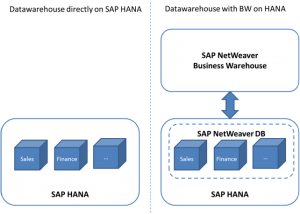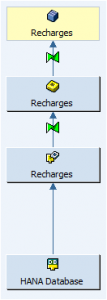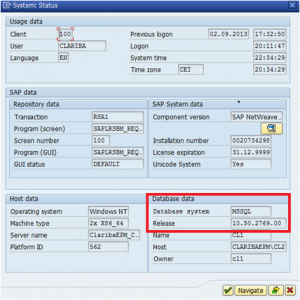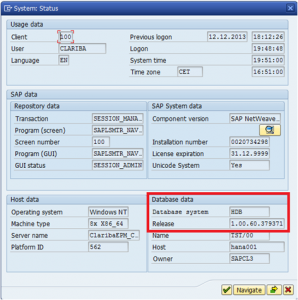In this article we will analyse the advantages of the SAP Business Warehouse (SAP BW) on SAP HANA solution in comparison with a Data Warehouse built directly on SAP HANA. We will also benchmark the performance of a SAP BW vs. SAP BW on HANA in a big data scenario. Most of us are aware of the last trends in BI/EPM market and where it is heading. SAP's mid and long term strategy shows that they are committed to convert SAP HANA in the core of many of their solutions including SAP ERP and SAP BW. SAP HANA can be used either as a database for other Custom Applications or as an Enterprise Corporate Datawarehouse (EDW) to take advantage of its big data and in-memory capabilities.
What options do we have when implementing an Enterprise Data Warehouse in SAP HANA?
When creating an Enterprise Data Warehouse (EDW) in SAP HANA, SAP customers have 2 options
EDW in SAP HANA: Implementing a Data Model inside SAP using a combination of custom data models implemented by BI consultants, models created using SAP RapidMarts and SAP Data Services as a modelling tool.
EDW in SAP BW on HANA: Implementing the SAP Business Warehouse on HANA by taking advantage of its complete data warehousing workbench and its rich business content, which provides Data Models and ETL for almost all modules in a SAP ERP system.
EDW in SAP HANA or EDW in SAP BW on SAP HANA?
Many SAP customers are now facing a dilemma. They want to go for SAP HANA, however, they don’t know yet whether to go for option 1 or 2. My suggestion is that the following customers go for SAP BW on HANA:
Those who already have a SAP BW system. They can quickly migrate that system into a BW on HANA (and Clariba can help on that) and take advantage of in-memory and big data capabilities of SAP HANA by protecting previous investments on that BI system.
Companies with SAP ERP that currently don't have an EDW. SAP BW is a very good solution to create a data warehouse on top of other SAP Systems as integration between them is tighter and it comes with all pre-developed data models.
What are the weak points of SAP BW on SAP HANA?
Companies with no other SAP systems in the landscape can theoretically go for SAP BW to implement their custom data models (no business content), however, that has some disadvantages:
ETL Implementation effort is not so quick as compared to ETL implementation with SAP Data Services
Data Models implemented within SAP BW will be a bit slower than data models implemented directly into a SAP HANA database. That’s because we are adding a layer with the NetWeaver application server on top of the SAP HANA Database.
What are the advantages of SAP BW on SAP HANA?
SAP BW on SAP HANA has some advantages in front of a plain data warehouse in SAP HANA:
SAP BW is a data warehouse framework. You have several capabilities you may expect from a data warehouse. Plain SAP HANA is not so mature and complete.
Plain SAP HANA lacks Master Data Management capabilities
Data warehousing development workbench
It comes with and engine that automatically manages dimensions, Master Data ID’s, hierarchies. In comparison, implementing a Data Warehouse directly on SAP HANA seems to be handcraft and highly depends on the BI Consultant skills
Better capability to automatically manage data loads and solve issues/ ie: if a load fails, you can easily delete the load an repeat it
BW is a more business focused data warehouse than a data warehouse directly in SAP HANA, which is more technical. You can carry out large SAP BW projects without scripting SQL queries. It’s not the same with a large project involving a plain SAP HANA data warehouse, in which you will need to script SQL
For SAP BW customers, what are the improvements of migrating to SAP BW on SAP HANA?
SAP BW customers need to assess whether the investment on a new SAP HANA appliance makes sense. Cleary the investment is valid for customers with SAP BW systems containing huge amount of data and suffering poor query reporting performance. Also to consider that with SAP BW on SAP HANA less database space is used as fewer indexes are needed and aggregates are no longer necessary.
These customers must consider that the SAP HANA database in which the SAP BW will be running can be used for other enterprise applications, so your investment on the SAP HANA technology is not just for the SAP BW, but also for other applications.
What if we compare the SAP BW vs. SAP BW on SAP HANA?
We have a pool of sample data with millions of records coming from a telco scenario: prepaid recharges carried out by millions of customer during a frame of time. We want to compare the same scenario deployed in normal SAP BW vs. a SAP BW on HANA.
Extraction of 2.5 million records from source system. That source system is another SAP HANA database. Yes, we should see the scores in a non SAP HANA database, but in another article.
Load of these 2.5 million records into an Infocube. Transformation rules with 4 ABAP routines are used.
Execution of consolidated (without displaying millions of records) BEx queries on that InfoCube
Execution of a Web Intelligence report from that query.
Architecture
The scenario has been implemented on a SAP NetWeaver 7.3 SP9. SAP BusinessObjects BI Platform 4.1 used for the Web Intelligence reports.
Both servers have same RAM memory, hard disk, network speed, etc.
The following picture shows the architecture of both scenarios
SAP NetWeaver BW on a MS SQL Server Database installed in the same box (no network latency)
SAP NetWeaver BW on SAP HANA. The SAP HANA box is in a separate box and there is network latency.
Server 1 System Status
Server 2 System Status
Benchmark scores
Server 1
SAP BW 7.3
Server 2
SAP BW on HANA 7.3
vs.
Extraction of 2.5 million records time from source system
34 minutes 36 seconds
26 Minutes 6 seconds
1.32x faster
Load of these 2.5 million records into a Infocube
1h and 3 minutes
3 minutes 27 seconds
18.5x faster
Execution of consolidated BEx queries on that InfoCube
27.8 seconds
0.414 seconds
67.1x faster
Execution of a Web Intelligence report from that query.
138 seconds
11 seconds
12.5x faster
Conclusions
In this article we tried to compare the performance of SAP BW on SAP HANA vs. a non-SAP HANA BW. We used the same data model and amount of data in both cases just to quantify the difference in performance of both scenarios with real numbers. These are my conclusions
SAP BW on SAP HANA in much faster than BW on non HANA database. That improvement can range from 10 to 67 times, depending on what we execute.
SAP BW on ASP HANA performance on extraction depends on the speed of the source system. It can be a bit faster as records, once read, are inserted faster in the SAP HANA Database.
Loading records in Infoproviders of SAP BW on SAP HANA can be 10x or 20x times faster compared to a non-SAP HANA BW. That is highly variable depending on the database we compare with (in our case, a MS SQL Server)
Query and Analysis on SAP BW on SAP HANA is much faster. However, it depends on the type of query. If we just want to calculate figures, it will be faster than if we try to retrieve large number of records.
Web Inteligence reports on top of SAP BW on SAP HANA are faster, however the performance improvement is not so great when compared to directly executing the BEx query. This is due to the fact that SAP BusinessObjects needs to move data from sAP BW server to the SAP BusinessObjects server and load it into the Web Intelligence report. Will SAP release a SAP BusinesObjects system on SAP HANA? Let's wait and see





